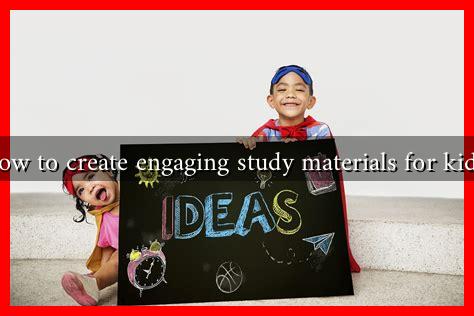-
Table of Contents
How to Create Engaging Study Materials for Kids
Creating engaging study materials for kids is essential for fostering a love of learning and enhancing educational outcomes. With the right approach, study materials can transform mundane lessons into exciting adventures that captivate young minds. This article explores effective strategies for developing engaging study materials that resonate with children.
Understanding Your Audience
Before diving into the creation of study materials, it’s crucial to understand the target audience. Kids have diverse learning styles, interests, and attention spans. Here are some key considerations:
- Age Appropriateness: Tailor materials to the specific age group.
. Younger children may benefit from colorful visuals and interactive elements, while older kids might prefer more complex content.
- Learning Styles: Incorporate various learning styles—visual, auditory, and kinesthetic—to cater to different preferences.
- Interests: Integrate themes and topics that resonate with children’s interests, such as animals, space, or superheroes.
Incorporating Visual Elements
Visual aids can significantly enhance engagement and retention. Children are naturally drawn to colors, images, and graphics. Here are some effective ways to incorporate visual elements:
- Infographics: Use infographics to present complex information in a simplified and visually appealing manner.
- Illustrations: Include illustrations or cartoons that relate to the subject matter, making it more relatable and fun.
- Videos and Animations: Short videos or animations can explain concepts in an entertaining way, keeping kids engaged.
Interactive Learning Activities
Interactive activities encourage active participation, making learning more enjoyable. Here are some ideas for interactive study materials:
- Quizzes and Games: Create quizzes or educational games that reinforce learning through competition and fun.
- Hands-On Projects: Design projects that require kids to create something tangible, such as models or art pieces related to the lesson.
- Group Activities: Encourage collaboration through group projects or discussions, fostering social skills alongside academic learning.
Utilizing Technology
In today’s digital age, technology can be a powerful tool for creating engaging study materials. Here are some ways to leverage technology:
- Educational Apps: Use apps designed for learning that offer interactive exercises and games tailored to various subjects.
- Online Resources: Incorporate online platforms that provide videos, articles, and interactive content, such as Khan Academy.
- Virtual Reality: Explore virtual reality experiences that allow kids to immerse themselves in different environments related to their studies.
Case Studies and Success Stories
Several educational institutions have successfully implemented engaging study materials, leading to improved student outcomes. For instance, a study conducted by the University of California found that students who used interactive learning tools scored 20% higher on assessments compared to those who used traditional materials. Another example is the use of gamification in classrooms, where teachers reported increased motivation and participation among students.
Feedback and Iteration
Creating engaging study materials is an ongoing process. Gathering feedback from students and educators can provide valuable insights into what works and what doesn’t. Consider the following:
- Surveys: Conduct surveys to understand students’ preferences and areas of difficulty.
- Focus Groups: Organize focus groups with students to discuss their experiences with the materials.
- Iterative Design: Be open to revising and improving materials based on feedback to enhance engagement continuously.
Conclusion
Creating engaging study materials for kids is a multifaceted endeavor that requires understanding the audience, incorporating visual elements, utilizing technology, and fostering interactivity. By implementing these strategies, educators and parents can create a stimulating learning environment that not only enhances knowledge retention but also instills a lifelong love of learning. Remember, the goal is to make learning fun and accessible, paving the way for future academic success.





